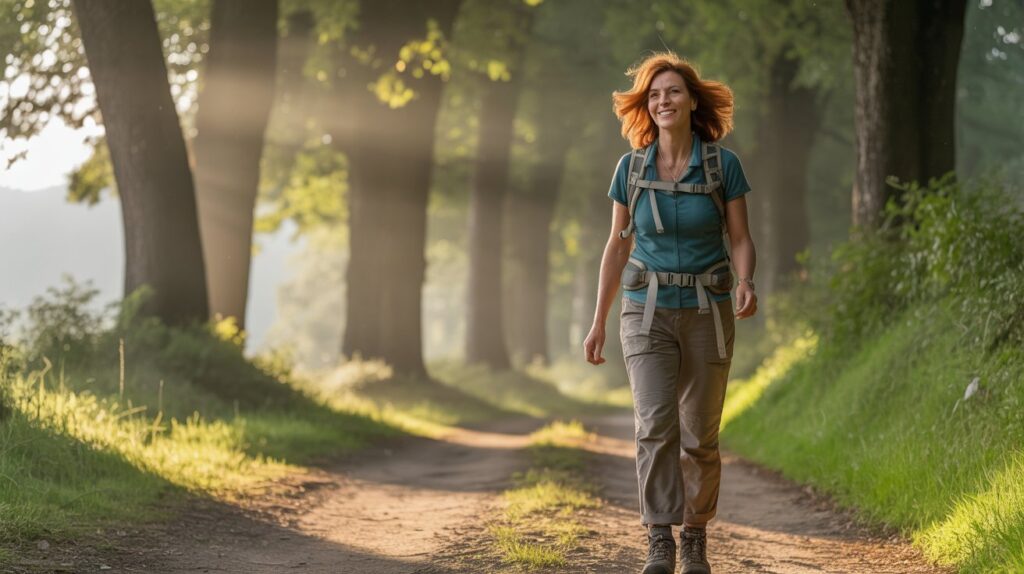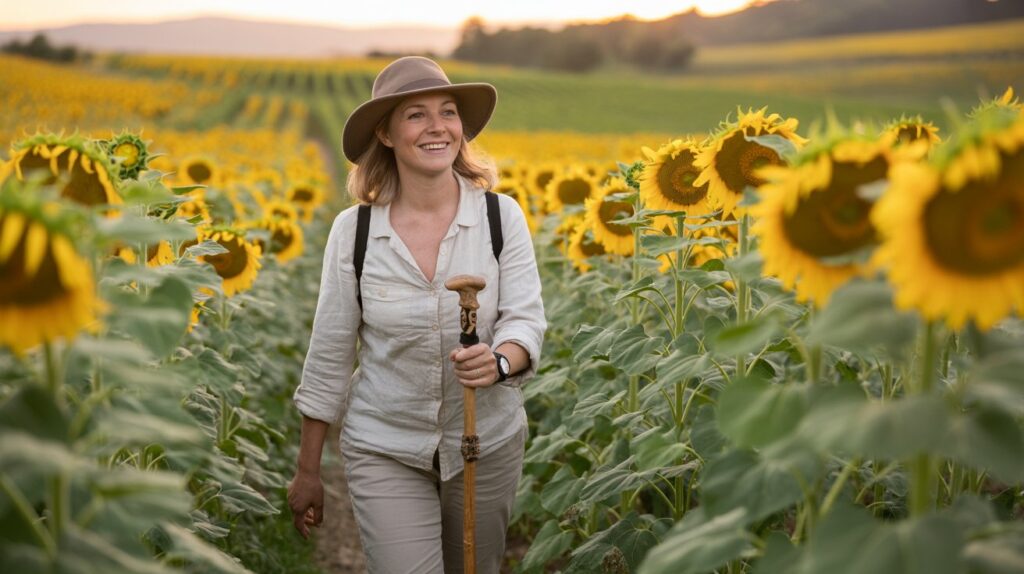When life gets overwhelming, do you reach for the phone to call a friend? Make tea for everyone, even though you’re the one falling apart? Organise a girls’ night out? That’s not weakness—that’s your nervous system’s brilliant survival strategy in action. While traditional stress research focuses on fight-or-flight, women often have a completely different response: we tend (nurture and care for others) and befriend (strengthen our social bonds). This article explores why women instinctively gather their tribe during crisis, why that’s actually your superpower, and how understanding this changes everything about managing stress during life’s major transitions.
5 Key Takeaways
- The tend-and-befriend stress reaction is biological, not cultural. Oxytocin, released during stress in women, drives us toward connection rather than isolation.
- This response pattern is equally valid as fight-or-flight but has been historically overlooked in stress research that primarily studied men.
- Tend-and-befriend becomes particularly crucial during major life transitions—precisely when women aged 35-65 need it most.
- Understanding your natural stress reaction helps you stop judging yourself for “not being strong enough” when you seek support.
- Intentional community-building—from walking groups to storytelling circles—isn’t indulgent; it’s essential stress management.
Introduction: The Invitation You Didn’t Know You Needed
Picture this: Your world is crumbling. Perhaps it’s divorce papers on the kitchen table, redundancy notice in your inbox, or the sudden silence of an empty nest. What do you do?
If you’re like most women, your first instinct isn’t to run away (flight), pick a fight (fight), shut down completely (freeze), or desperately please everyone (fawn). No—you ring your best friend. You put the kettle on. You gather your people.
And then you judge yourself for it.
“I should be stronger,” you think. “Why can’t I handle this alone?”
But what if I told you that this instinct to reach out, to nurture others whilst seeking comfort yourself, isn’t a weakness at all? What if it’s actually your nervous system’s most sophisticated survival strategy—one that science ignored for decades because researchers primarily studied stressed-out male rats and university lads?
Welcome to the revolutionary world of tend-and-befriend: the stress reaction pattern that’s been hiding in plain sight, waiting to validate what women have known intuitively for millennia.
Andrea White’s Story: The Woman Who Tried to Be an Island
Andrea White arrived at one of my Camino de Santiago retreat’s storytelling circles in the Gers region of south-west France with shoulders hunched like question marks and a smile that didn’t quite reach her eyes. Fifty-three years old, recently divorced, and utterly convinced she needed to “woman up” and face her new life alone.
“I’m not here to make friends,” she announced on our first evening, as three other women settled onto cushions in the ancient stone barn, candlelight dancing across weathered beams. “I just need to walk. Clear my head. Get strong.”
I recognised that particular brand of fierce independence immediately. I’d worn it myself once—like armour that’s actually a cage.
The Gers countryside stretched before us: rolling hills of sunflowers, medieval villages perched like crowns on hilltops, and the white-and-gold path of the Camino winding through it all. We’d spend three days walking, meditating, and sharing stories.
Andrea walked alone that first day. Quite deliberately. When others paired up, chatting and laughing, she strode ahead, jaw set, earbuds firmly in place. At our midday rest stop—a perfect picnic beneath plane trees, with fresh bread, local cheese, and tomatoes that tasted of pure sunshine—she sat apart, scrolling her phone.
“She’s hurting,” whispered Marie, a French teacher from Lyon.
“She’s terrified,” added Susan, a doctor from Edinburgh.
By day three, Andrea’s isolation had become almost comical. She’d speed-walk ahead, but we’re a persistent lot on these retreats. Someone would inevitably catch her up. “Gorgeous view, isn’t it?” “Did you try the plum tart at breakfast?” “My feet are killing me—are yours?”
I watched her defences crack like dried mud in rain.
It happened properly on day three. We’d stopped at a tiny chapel, barely larger than a garden shed, its interior cool and dark after the fierce August sun. The smell of old incense and candles mixed with lavender from the fields outside. Inside, a visitors’ book lay open, filled with prayers and hopes scrawled in dozens of languages.
Andrea stood reading them, and I saw her shoulders begin to shake.
That evening’s storytelling circle was different. We’d built a fire carefully—crackling oak, the smoke sweet and sharp, stars appearing one by one in the darkening sky. The ritual is always the same: whoever holds the talking stick shares what they need to share. Sometimes it’s funny. Sometimes profound. Often both.
Andrea took the stick with trembling hands.
“I’ve been so angry,” she began, her voice rough as sandpaper. “Angry at my ex-husband. Angry at myself. But mostly—” she paused, tears now flowing freely, reflecting firelight like tiny amber rivers, “—I’ve been furious at myself for needing people. For not being able to just… cope alone.”
She told us everything then. The twenty-five-year marriage that had slowly suffocated her. The adult children who’d moved away. The career she’d sacrificed. The friends she’d lost touch with because her husband hadn’t liked them. And underneath it all, the crushing shame of needing help.
“When the stress hit,” she said, “everyone kept telling me about fight-or-flight. My therapist, my GP, the self-help books. They said I needed to fight for myself or remove myself from the situation. But all I wanted—” her voice broke, “—all I wanted was for someone to sit with me. To just… be there.”
Around the circle, women nodded. The knowing was palpable, thick as the wood smoke.
“I thought that made me weak,” Andrea whispered.
That’s when Susan spoke. “That’s oxytocin, love. That’s your stress reaction doing exactly what it’s meant to do.”
What happened next was pure magic—the kind that only occurs when women stop performing strength and start practising it. We spent three hours by that fire, sharing stories of times we’d felt broken for seeking connection, ashamed for not being “strong enough” to isolate ourselves through pain.
By dawn, Andrea was sleeping peacefully, surrounded by new friends who’d promised to WhatsApp daily, to visit, to stay connected. She’d walked alone for three days. She’d spend the next weeks walking hand-in-hand with her tribe.
The Science Behind the Sisterhood: Understanding Tend-and-Befriend
For decades, stress research focused almost exclusively on the fight-or-flight response—that adrenaline-fuelled reaction where your body prepares either to battle the threat or leg it in the opposite direction. This model, developed largely from studies on male subjects (both human and animal), became the default understanding of how humans respond to stress.
But here’s the fascinating bit: it’s incomplete.
In 2000, psychologist Dr Shelley Taylor and her colleagues at UCLA published groundbreaking research identifying a distinctly different stress reaction pattern, observed predominantly in women: tend-and-befriend – Taylor SE, Klein LC, Lewis BP, Gruenewald TL, Gurung RA, Updegraff JA. Biobehavioral responses to stress in females: tend-and-befriend, not fight-or-flight. Psychol Rev. 2000 Jul;107(3):411-29.
When women experience stress, particularly chronic or social stress, our bodies release oxytocin alongside the usual stress hormones. This “bonding hormone” doesn’t just make us feel warm and fuzzy—it actively drives us toward social connection and nurturing behaviours. Instead of fighting or fleeing, we tend (care for offspring and others) and befriend (build and strengthen social networks).
This isn’t socialisation or cultural conditioning (though those certainly reinforce it). It’s biology. Evolution shaped this response because, for most of human history, a woman’s survival—and her children’s survival—depended not on her individual ability to outfight or outrun threats, but on the strength of her social bonds.
Think about it: when danger threatened our ancestors, men might benefit from aggressive defence or rapid escape. But women, often pregnant or caring for young children, needed different strategies. Gathering together, sharing resources, and maintaining strong community bonds became survival tools as powerful as any spear or swift legs.
The tend-and-befriend stress reaction offers remarkable benefits:
Stress buffering: Social connection literally dampens our stress response. When we’re with trusted friends, our cortisol levels decrease, our heart rate stabilises, and our nervous system calms.
Enhanced resilience: Women with strong social networks navigate major life transitions—divorce, bereavement, illness, career changes—with significantly better mental and physical health outcomes.
Collective wisdom: When we gather and share experiences, we access perspectives and solutions we’d never discover alone. Your crisis becomes less overwhelming when you realise others have weathered similar storms.
Oxytocin’s magic: This hormone not only motivates social connection but also reduces anxiety and promotes healing. It’s literally nature’s antidote to stress.
Yet despite this biological imperative toward connection, we live in a culture that often valorises isolation as strength. “I’m fine on my own,” we say proudly, as though needing others reflects poorly on our character.
This is particularly damaging during the transitional years between 35 and 65, when women face some of life’s most profound shifts. Empty nests. Caring for ageing parents. Menopause. Divorce. Career pivots. Bereavement. These aren’t moments for stoic isolation—they’re precisely when our tend-and-befriend response should be activated at full throttle.
The problem? Many of us have spent decades disconnecting from this natural response. We’ve absorbed messages about independence and self-sufficiency to such a degree that we’ve forgotten how to properly tend and befriend. We’ve let friendships atrophy. We’ve prioritised productivity over community. We’ve worn our ability to “cope alone” like a badge of honour.
And then stress hits, our bodies scream for connection, and we judge ourselves for the need.
Understanding tend-and-befriend isn’t just intellectually interesting—it’s transformative. It means that when you reach for the phone during a crisis, you’re not being weak; you’re being wise. When you organise a girls’ weekend or join a walking group or book yourself onto a retreat, you’re not being indulgent; you’re practising essential stress management.
Your nervous system knows what it needs.
Further Reading: Five Unconventional Books
1. “Tending the Fire: Through Conflict, Trauma and Tragedy, What We Share in Common Is Seeking Peace” by Tending the Fire Collective (edited by Molly Remer)
This isn’t a traditional academic text—it’s a collection of women’s voices exploring how we hold space for each other through crisis. What makes this book invaluable is that it demonstrates tend-and-befriend in action rather than just theorising about it. The contributors—mothers, activists, healers, and ordinary women—share raw, honest accounts of how they’ve created circles of care during their darkest moments. I chose this because it mirrors what I witness in my storytelling circles: the transformative power of women simply showing up for each other. It’s proof that tending isn’t passive or weak; it’s revolutionary resistance against a culture that insists we suffer alone.
2. “The Tend and Befriend Theory of Stress: A New Perspective on Women’s Responses to Stress” (published research collection, available through academic libraries)
For those who want the actual science straight from the source, this collection includes Dr Shelley Taylor’s original groundbreaking research along with subsequent studies that expanded our understanding of women’s stress responses. Yes, it’s more academic, but Taylor writes accessibly, and reading the research that overturned decades of male-centred stress theory is genuinely thrilling. I recommend this because understanding the biological mechanisms—the interplay of oxytocin, oestrogen, and social bonding—gives you scientific ammunition when others suggest your need for connection during stress is somehow “emotional” rather than physiological. It validates what you’ve always known in your bones.
3. “Linked: How Everything Is Connected to Everything Else and What It Means for Business, Science, and Everyday Life” by Albert-László Barabási
This might seem an unexpected choice for a book about women’s stress responses, but stay with me. Barabási, a network scientist, explores how connection and networks function across all systems—from the internet to disease transmission to social relationships. What makes this relevant is his research showing that the strength of a network lies not in isolated strong nodes but in the quality and diversity of connections between nodes. Reading this, I had a revelation: tend-and-befriend isn’t just a stress response; it’s women instinctively understanding network theory. We’re not building dependencies; we’re creating resilient systems. When one node struggles, the network redistributes support. It’s brilliant, interconnected survival—and this book explains why it works so effectively.
4. “The Village Effect: How Face-to-Face Contact Can Make Us Healthier and Happier” by Susan Pinker
This isn’t another self-help manifesto telling you to journal your feelings. Pinker, a developmental psychologist, presents compelling evidence that in-person social contact is as important to longevity as giving up smoking. I chose this because it validates what my Camino retreats demonstrate repeatedly: there’s something irreplaceable about physical presence, shared meals, walking side-by-side, and actual eye contact. Zoom calls are lovely, but they don’t trigger the same biological stress-buffering responses as sitting around a fire with other humans.
5. “Women Who Run With the Wolves” by Clarissa Pinkola Estés
This might seem an odd choice, but hear me out. Estés, a Jungian analyst and cantadora (keeper of old stories), explores women’s wild nature through myth and fairy tale. Her work reminds us that gathering to share stories isn’t frivolous—it’s ancient feminine practice, a way of passing wisdom and processing experience that predates written language. After years of running storytelling circles, I’ve witnessed the profound healing that occurs when women reclaim this tradition. Estés articulates why it matters so deeply.
“I arrived at Margaretha’s Camino retreat convinced that asking for help meant I’d failed somehow. After thirty years in corporate law, I’d built my entire identity around being the person others leaned on. When my mother died and I fell apart, I was horrified by my own neediness. The retreat changed everything. Walking with other women, sharing stories around the fire, practising meditation together—I finally understood that connection isn’t weakness; it’s how we’re meant to move through pain. The tend-and-befriend concept gave me permission to be human. Six months on, I still WhatsApp my Camino sisters weekly. They’ve become my lifeline.” — Rachel M., London
FAQs about Tend-and-Befriend
Q: Is tend-and-befriend only a female stress reaction?
Not exclusively, but predominantly. Men can and do experience tend-and-befriend responses, particularly in nurturing contexts (fatherhood, caregiving roles). However, hormonal differences—specifically the interaction between oxytocin and testosterone—mean this pattern is more consistently observed in women. Testosterone appears to reduce oxytocin’s social bonding effects, whilst oestrogen enhances them.
Q: What if I’m a woman who doesn’t feel drawn to “befriending” during stress?
Perfectly valid! Stress responses exist on a spectrum, and individual variation is normal. Some women do default to fight-or-flight patterns. Others might have learned to suppress tend-and-befriend impulses due to past experiences where seeking connection felt unsafe. The key is noticing your authentic response without judgment and ensuring you have adequate stress-management strategies that work for your nervous system.
Q: Can you develop tend-and-befriend responses if they don’t come naturally?
Absolutely. Like any skill, building and maintaining social connections strengthens with practice. Start small: regular coffee dates, joining a walking group, attending workshops or retreats. Notice what happens in your body when you’re with trusted others during stressful periods. Your nervous system can learn that connection equals safety, which gradually makes reaching out feel more natural.
Q: How is this different from codependency or people-pleasing (fawning)?
Brilliant question. Tend-and-befriend is about mutual support and authentic connection—you give and receive care within healthy boundaries. Fawning is a trauma response where you prioritise others’ needs to avoid conflict or rejection, often at significant cost to yourself. The difference lies in reciprocity, choice, and whether the connection genuinely soothes your nervous system or leaves you depleted and resentful.
Q: What about introverts who find social interaction draining?
Introversion relates to how you recharge energy (alone time versus social time), not whether you need connection. Introverted women still benefit enormously from tend-and-befriend responses—they just need to structure connection differently. Smaller gatherings, one-on-one walks, written correspondence, or time-limited social events can all activate the stress-buffering benefits of connection without overwhelming your system. Quality matters far more than quantity.
Conclusion: Reaching Out
We’ve been sold a lie about strength—that it means gritting teeth and soldiering on alone, that needing others reflects some fundamental inadequacy within us.
But your body knows better. When stress strikes and you feel that pull toward connection, toward sharing your story, toward gathering your people—that’s not weakness whispering. That’s wisdom. That’s millions of years of evolutionary intelligence reminding you that humans are tribal creatures who survive and thrive through connection.
The tend-and-befriend stress reaction isn’t a lesser response to fight-or-flight. It’s a sophisticated, deeply effective strategy for navigating life’s inevitable storms, particularly those transitional periods when everything familiar seems to be shifting beneath your feet.
So the next time stress sends you reaching for the phone, booking coffee with a friend, or considering a retreat with strangers who might become sisters—don’t judge that impulse. Honour it. Your nervous system is doing exactly what it’s meant to do.
And perhaps, just perhaps, what you’re really seeking isn’t someone to fix your problems or tell you what to do. Perhaps you’re seeking the oldest medicine humans possess: the healing that occurs when we stop pretending we’re islands and remember we’re part of an archipelago.
You don’t have to walk this path alone. You were never meant to.
Walk Your Story into Being: Join a Camino de Santiago Retreat
Imagine this: walking the ancient Camino de Santiago through the honey-coloured hills of south-west France, where medieval villages crown hilltops and sunflower fields stretch toward the distant Pyrenees mountains. This isn’t a hiking holiday. It’s a coming home—to yourself.
Our Camino de Santiago Crossroads Retreats combine gentle daily walking (no hardcore fitness required—just willingness and comfortable shoes) with mindfulness practices that ground you in the present moment, meditation exercises specifically designed for stress management, and evening storytelling circles where transformation happens around the fire.
You’ll sleep in an old French farmhouse, eat meals prepared from local markets, and walk paths where millions of pilgrims have processed their own transitions over a thousand years. The rhythm of walking, the beauty of the landscape, and the companionship of others navigating life’s crossroads create the perfect conditions for healing and clarity.
This is where your tend-and-befriend response gets exactly what it’s been asking for: time in nature, meaningful connection, space to share your story and hear others’, and practices that help your nervous system remember what peace feels like.
Because life’s crossroads aren’t meant to be navigated alone. They’re invitations to gather your tribe and walk into what’s next—together.
Discover more and reserve your spot: Camino de Santiago Crossroads Retreat










“I am an experienced medical doctor – MBChB, MRCGP, NLP master pract cert, Transformational Life Coach (dip.) Life Story Coach (cert.) Stress Counselling (cert.) Med Hypnotherapy (dip.) and EAGALA (cert.) I may have an impressive number of letters after my name, and more than three decades of professional experience, but what qualifies me to excel at what I do is my intuitive understanding of my clients’ difficulties and my extensive personal experience of managing major life changes using strategies I developed over many years.” Dr M Montagu

